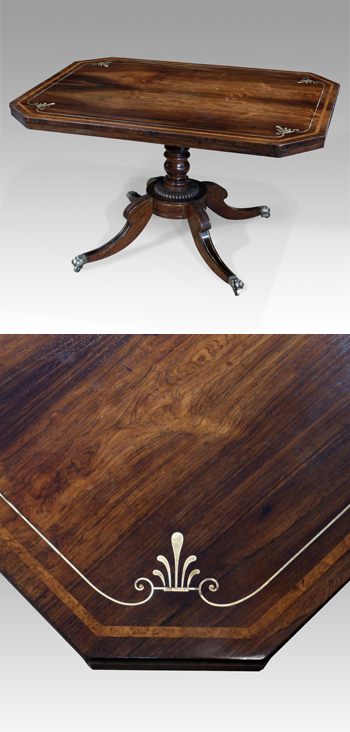As a furniture style, Regency has  come to embrace a period from the 1790s to about 1830. Strictly, Regency means 1811-1820 which was the period the Prince of Wales (later George IV) acted as Regent during his father’s period of insanity. The Prince presided over the rebuilding of much of central London, with possibly his most impressive achievement being Carlton House – Regency high style at its most sumptuous.
come to embrace a period from the 1790s to about 1830. Strictly, Regency means 1811-1820 which was the period the Prince of Wales (later George IV) acted as Regent during his father’s period of insanity. The Prince presided over the rebuilding of much of central London, with possibly his most impressive achievement being Carlton House – Regency high style at its most sumptuous.
Brighton Pavilion, a product of the collaboration between the Prince and Henry Holland, was a lavish oriental fantasy with onion-shaped domes and Moorish arches, pierced stone facades and tall arched windows. The Prince commissioned the design, for a new building in the Oriental style, from John Nash. He had the walls decorated with mandarins and fluted yellow draperies to resemble Chinese tents, and Oriental treasures of all kinds
The major source of inspiration for Regency taste was found in Greek and Roman antiquity. A taste for Egyptian motifs, resulting from the Napoleonic expeditions to Egypt, also became part of the Regency fashion. Variations in the Regency period also produced a resurgence of the Chinese theme seen in imitation bamboo and in painted and “japanned” black and gold lacquer pieces, most notably at Brighton Pavilion – George Smith (1756-1826) and Thomas Hope (1769-1831) both designed furniture for the Royal Pavilion. Classical proportions and elegant design have combined to make this one of the most admired periods of English furniture making.
Another important Regency personality was Nelson (1758-1805). Admiral Nelson’s much publicized victories at sea had a powerful effect on English Regency furniture design. Ebony was used to decorate furniture as a sign of mourning, and some chairs were carved in imitation of Nelson’s draped sarcophagus. Seafaring motifs abounded, their best-known use is on Sheraton’s ‘Nelson chair’, or ‘Trafalgar Chair’, which has decorations of carved dolphins, anchors and rope on the splat.
The wood used for furniture during the Regency period was often mahogany, either solid or veneered. Rosewood became very fashionable wood for cabinetwork after 1800, and many Regency pieces were made entirely of it. Other exotic wood such as ebony and zebra wood were used combined with brass inlays. Brass inlays were cut from brass sheets and were frequently inlaid as narrow banding and stringing lines into rosewood and mahogany furniture; such as on this impressive centre table.